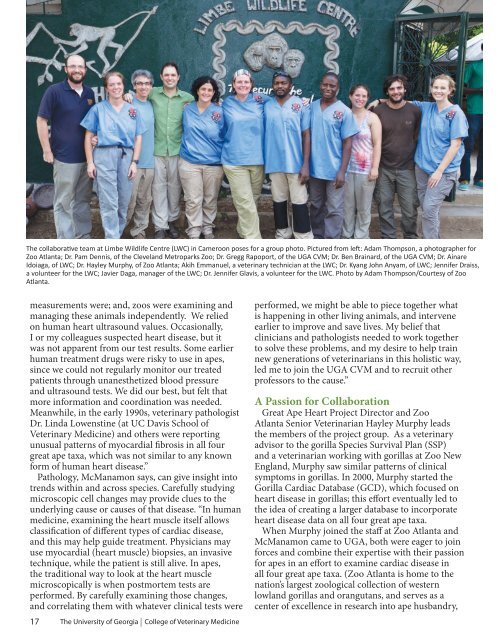Spring/Summer 2013 Aesculapian Magazine - University of Georgia ...
Spring/Summer 2013 Aesculapian Magazine - University of Georgia ...
Spring/Summer 2013 Aesculapian Magazine - University of Georgia ...
Create successful ePaper yourself
Turn your PDF publications into a flip-book with our unique Google optimized e-Paper software.
The collaborative team at Limbe Wildlife Centre (LWC) in Cameroon poses for a group photo. Pictured from left: Adam Thompson, a photographer for<br />
Zoo Atlanta; Dr. Pam Dennis, <strong>of</strong> the Cleveland Metroparks Zoo; Dr. Gregg Rapoport, <strong>of</strong> the UGA CVM; Dr. Ben Brainard, <strong>of</strong> the UGA CVM; Dr. Ainare<br />
Idoiaga, <strong>of</strong> LWC; Dr. Hayley Murphy, <strong>of</strong> Zoo Atlanta; Akih Emmanuel, a veterinary technician at the LWC; Dr. Kyang John Anyam, <strong>of</strong> LWC; Jennifer Draiss,<br />
a volunteer for the LWC; Javier Daga, manager <strong>of</strong> the LWC; Dr. Jennifer Glavis, a volunteer for the LWC. Photo by Adam Thompson/Courtesy <strong>of</strong> Zoo<br />
Atlanta.<br />
measurements were; and, zoos were examining and<br />
managing these animals independently. We relied<br />
on human heart ultrasound values. Occasionally,<br />
I or my colleagues suspected heart disease, but it<br />
was not apparent from our test results. Some earlier<br />
human treatment drugs were risky to use in apes,<br />
since we could not regularly monitor our treated<br />
patients through unanesthetized blood pressure<br />
and ultrasound tests. We did our best, but felt that<br />
more information and coordination was needed.<br />
Meanwhile, in the early 1990s, veterinary pathologist<br />
Dr. Linda Lowenstine (at UC Davis School <strong>of</strong><br />
Veterinary Medicine) and others were reporting<br />
unusual patterns <strong>of</strong> myocardial fibrosis in all four<br />
great ape taxa, which was not similar to any known<br />
form <strong>of</strong> human heart disease.”<br />
Pathology, McManamon says, can give insight into<br />
trends within and across species. Carefully studying<br />
microscopic cell changes may provide clues to the<br />
underlying cause or causes <strong>of</strong> that disease. “In human<br />
medicine, examining the heart muscle itself allows<br />
classification <strong>of</strong> different types <strong>of</strong> cardiac disease,<br />
and this may help guide treatment. Physicians may<br />
use myocardial (heart muscle) biopsies, an invasive<br />
technique, while the patient is still alive. In apes,<br />
the traditional way to look at the heart muscle<br />
microscopically is when postmortem tests are<br />
performed. By carefully examining those changes,<br />
and correlating them with whatever clinical tests were<br />
17<br />
The <strong>University</strong> <strong>of</strong> <strong>Georgia</strong> College <strong>of</strong> Veterinary Medicine<br />
performed, we might be able to piece together what<br />
is happening in other living animals, and intervene<br />
earlier to improve and save lives. My belief that<br />
clinicians and pathologists needed to work together<br />
to solve these problems, and my desire to help train<br />
new generations <strong>of</strong> veterinarians in this holistic way,<br />
led me to join the UGA CVM and to recruit other<br />
pr<strong>of</strong>essors to the cause.”<br />
A Passion for Collaboration<br />
Great Ape Heart Project Director and Zoo<br />
Atlanta Senior Veterinarian Hayley Murphy leads<br />
the members <strong>of</strong> the project group. As a veterinary<br />
advisor to the gorilla Species Survival Plan (SSP)<br />
and a veterinarian working with gorillas at Zoo New<br />
England, Murphy saw similar patterns <strong>of</strong> clinical<br />
symptoms in gorillas. In 2000, Murphy started the<br />
Gorilla Cardiac Database (GCD), which focused on<br />
heart disease in gorillas; this effort eventually led to<br />
the idea <strong>of</strong> creating a larger database to incorporate<br />
heart disease data on all four great ape taxa.<br />
When Murphy joined the staff at Zoo Atlanta and<br />
McManamon came to UGA, both were eager to join<br />
forces and combine their expertise with their passion<br />
for apes in an effort to examine cardiac disease in<br />
all four great ape taxa. (Zoo Atlanta is home to the<br />
nation’s largest zoological collection <strong>of</strong> western<br />
lowland gorillas and orangutans, and serves as a<br />
center <strong>of</strong> excellence in research into ape husbandry,

















